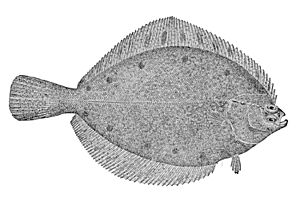Alaska plaice facts for kids
Quick facts for kids Alaska plaice |
|
|---|---|
 |
|
| Scientific classification | |
| Kingdom: | |
| Phylum: | |
| Class: | |
| Order: | |
| Family: | |
| Genus: |
Pleuronectes
|
| Species: |
P. quadrituberculatus
|
| Binomial name | |
| Pleuronectes quadrituberculatus Pallas, 1814
|
|
The Alaska plaice (scientific name: Pleuronectes quadrituberculatus) is a type of salt water fish that lives in the northern Pacific Ocean. Like most flatfish, these fish live on the bottom of the ocean, often on the continental shelf. They can be found in waters up to 600 metres (about 2,000 feet) deep.
Alaska plaice live across a wide area. Their home stretches from the Gulf of Alaska in the east, all the way north to the Chukchi Sea, and west to the Sea of Japan. They mostly eat small worms called polychaetes. They also enjoy eating tiny crustaceans called amphipods and other small sea creatures known as echiurans.
Fishing for Alaska Plaice
Even though many fishing companies are not trying to catch Alaska plaice, these fish are often caught by accident. This happens when large trawler boats are trying to catch other types of fish that live on the ocean floor.
Accidental Catches
Because so many Alaska plaice are caught by accident, sometimes the allowed amount of fish that can be caught in a year is reached very quickly. For example, in 2005, the limit for how many Alaska plaice could be caught in the Bering Sea and Aleutian Islands area was reached before the end of May. This shows how often they are caught as "bycatch" when fishing for other species.
Size and Lifespan
Alaska plaice can live for a long time, sometimes up to 30 years. They can grow to be about 60 centimetres (24 inches) long. However, most of the fish that are caught are much younger and smaller. They are usually around seven or eight years old and about 30 cm (12 in) long.
See Also

